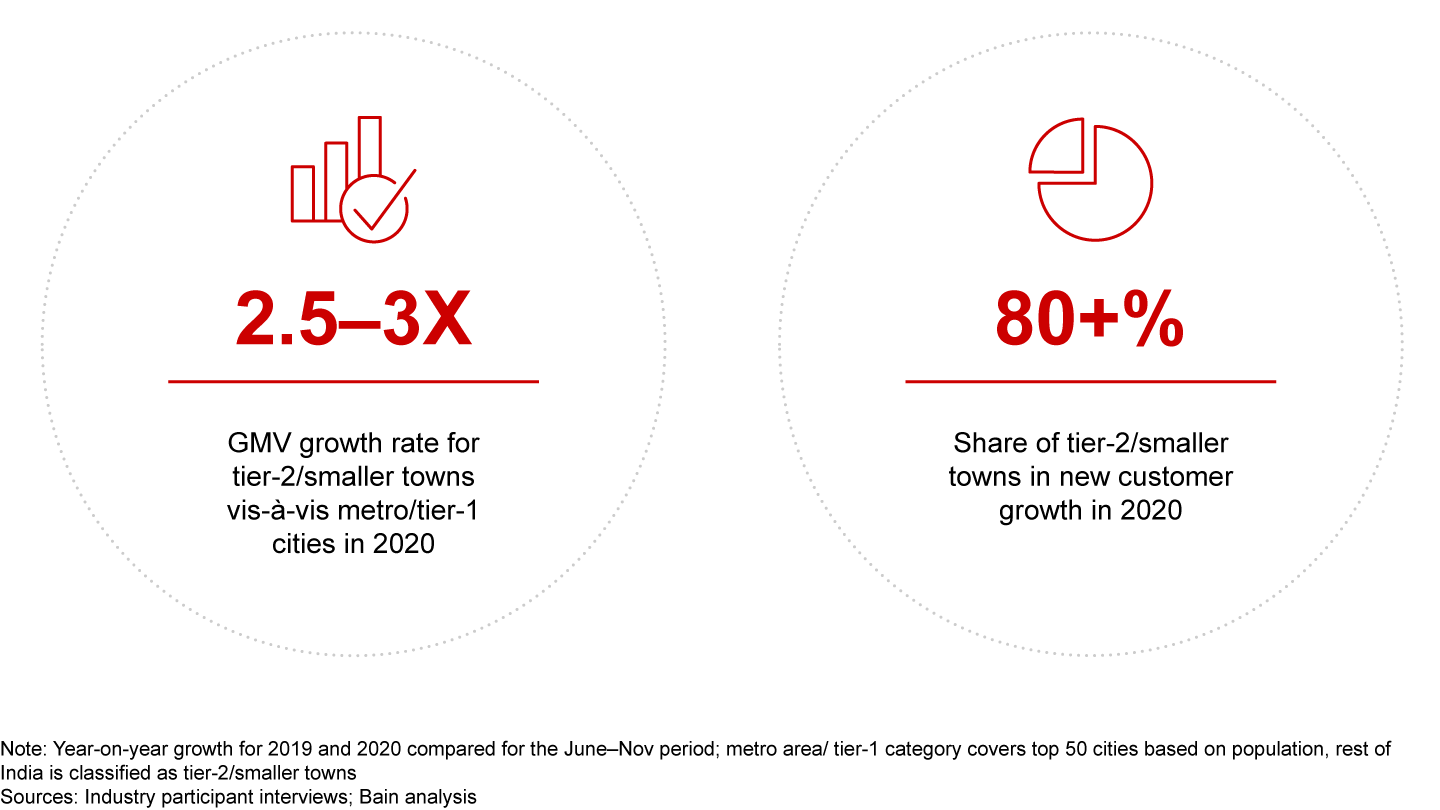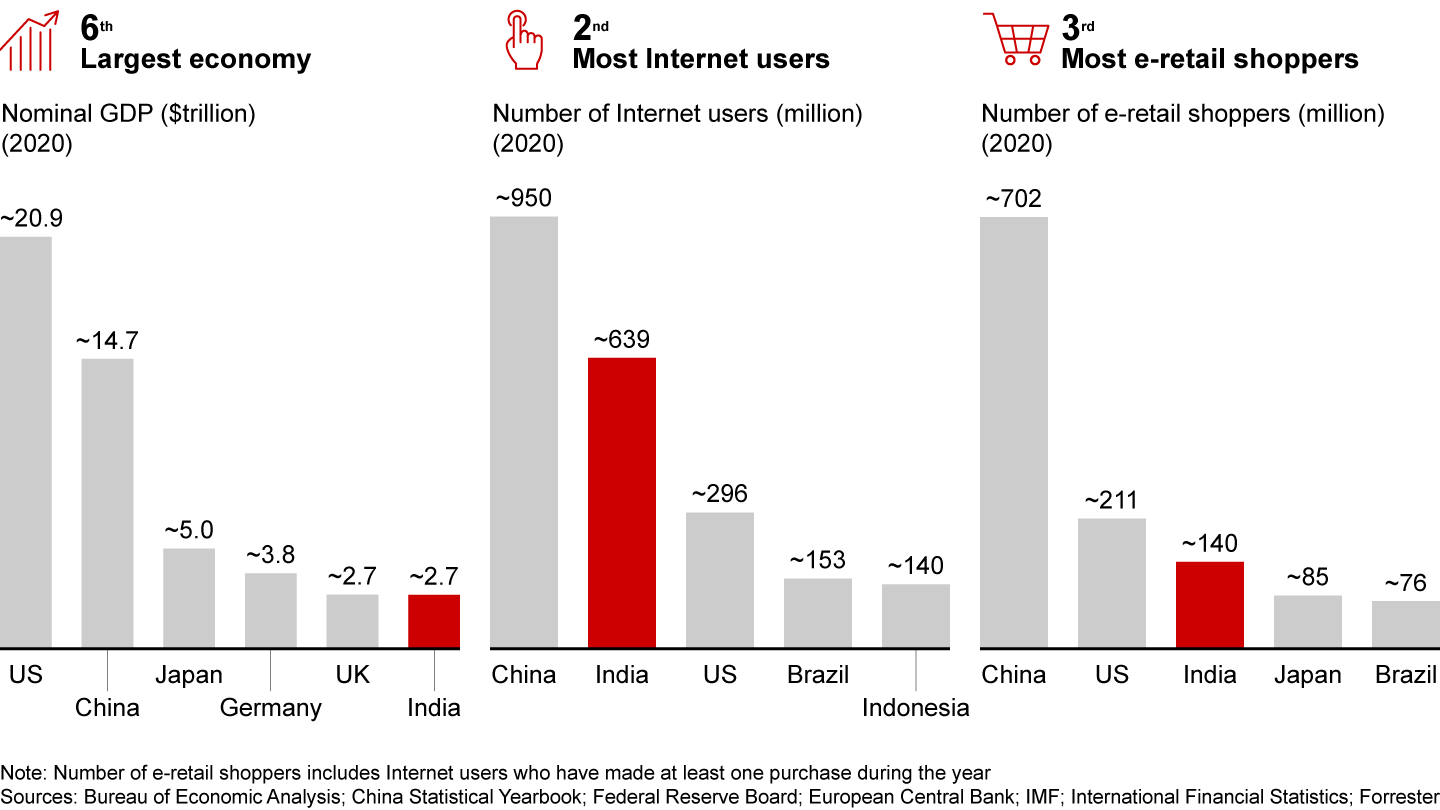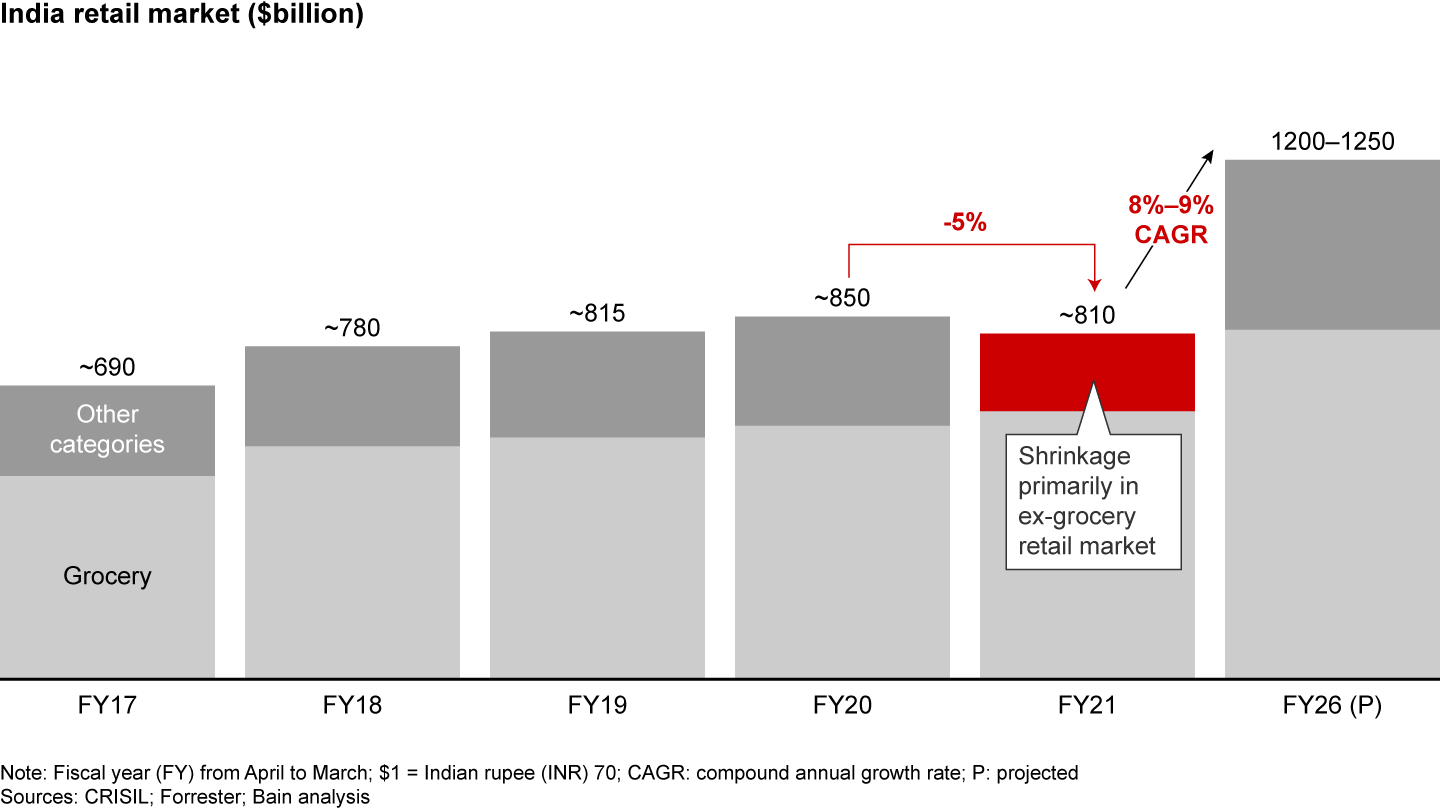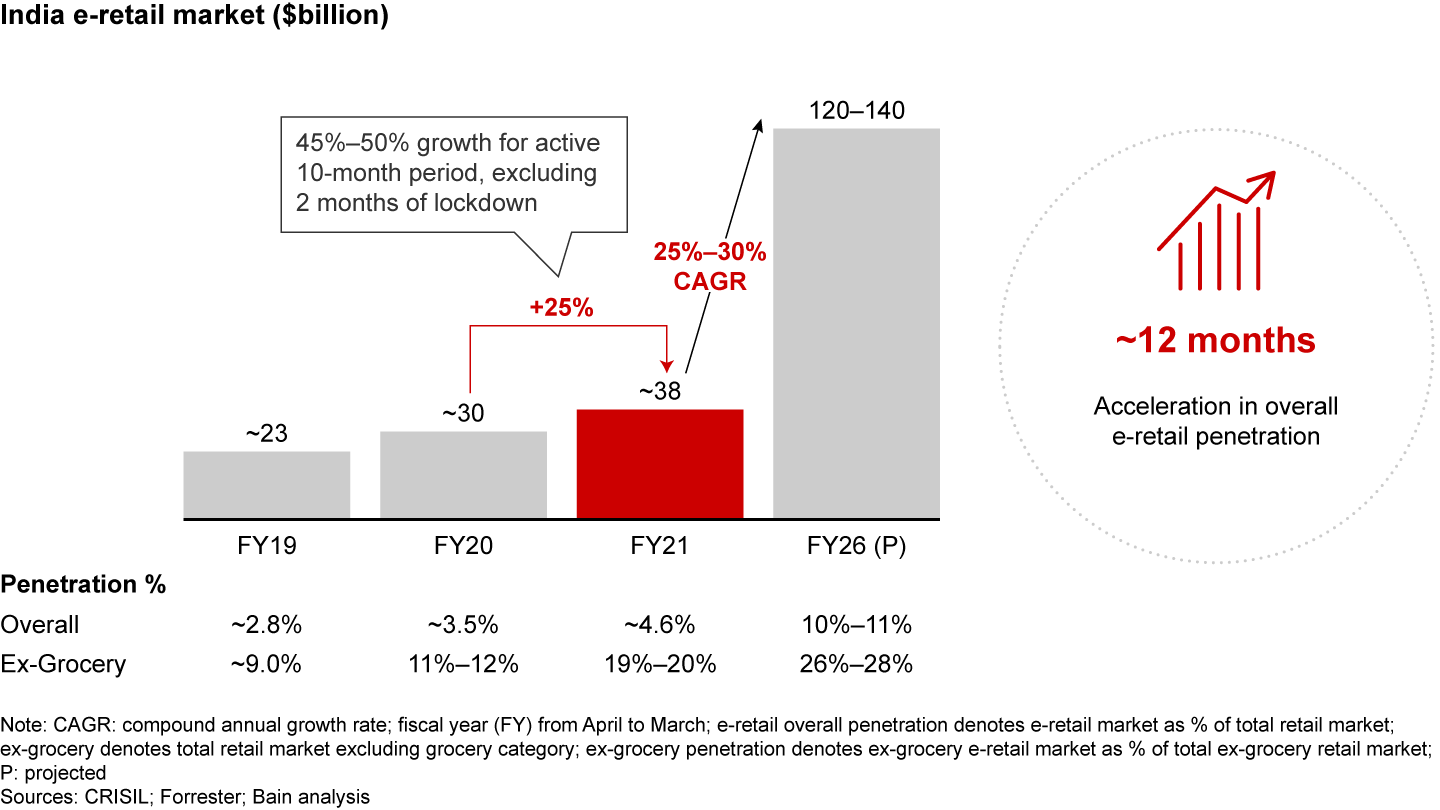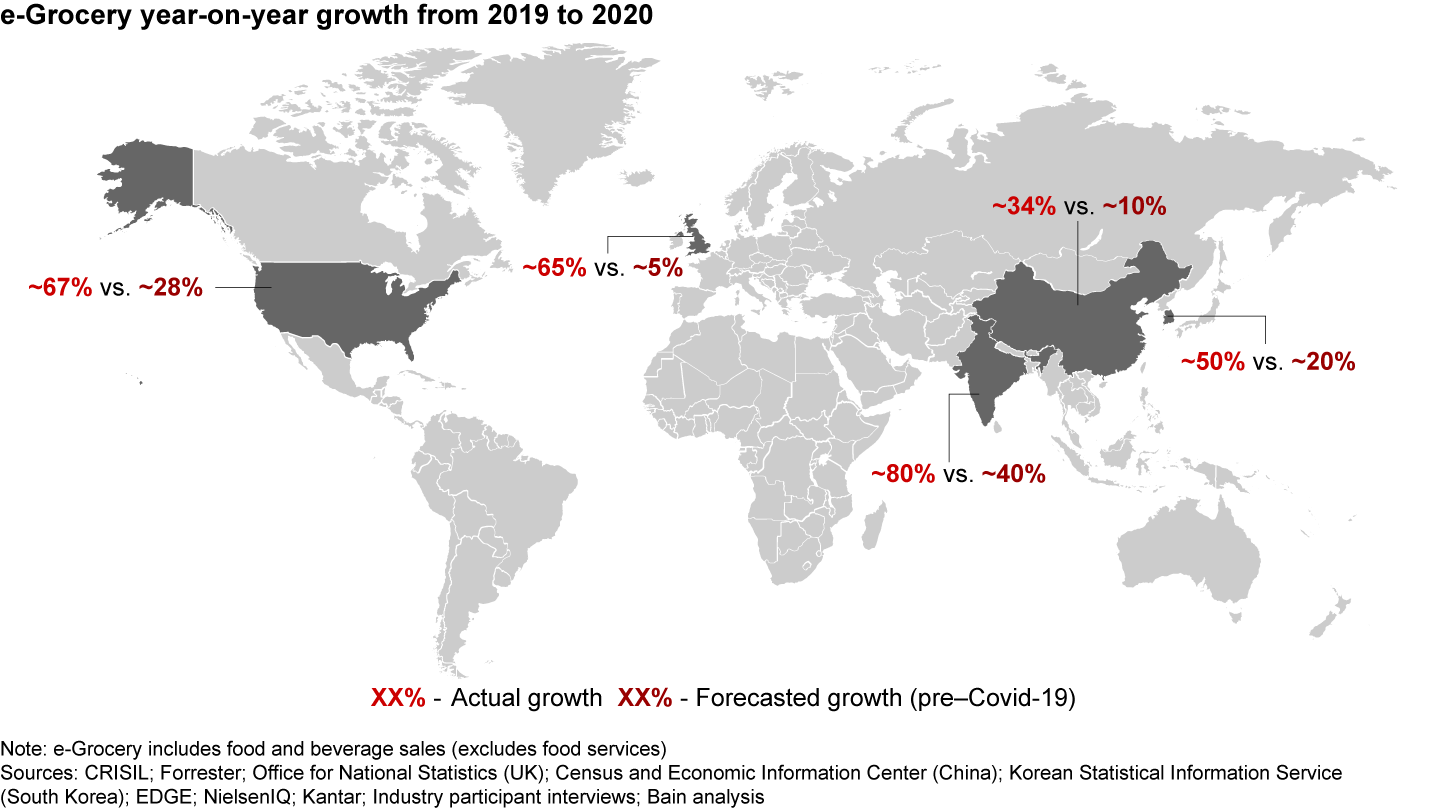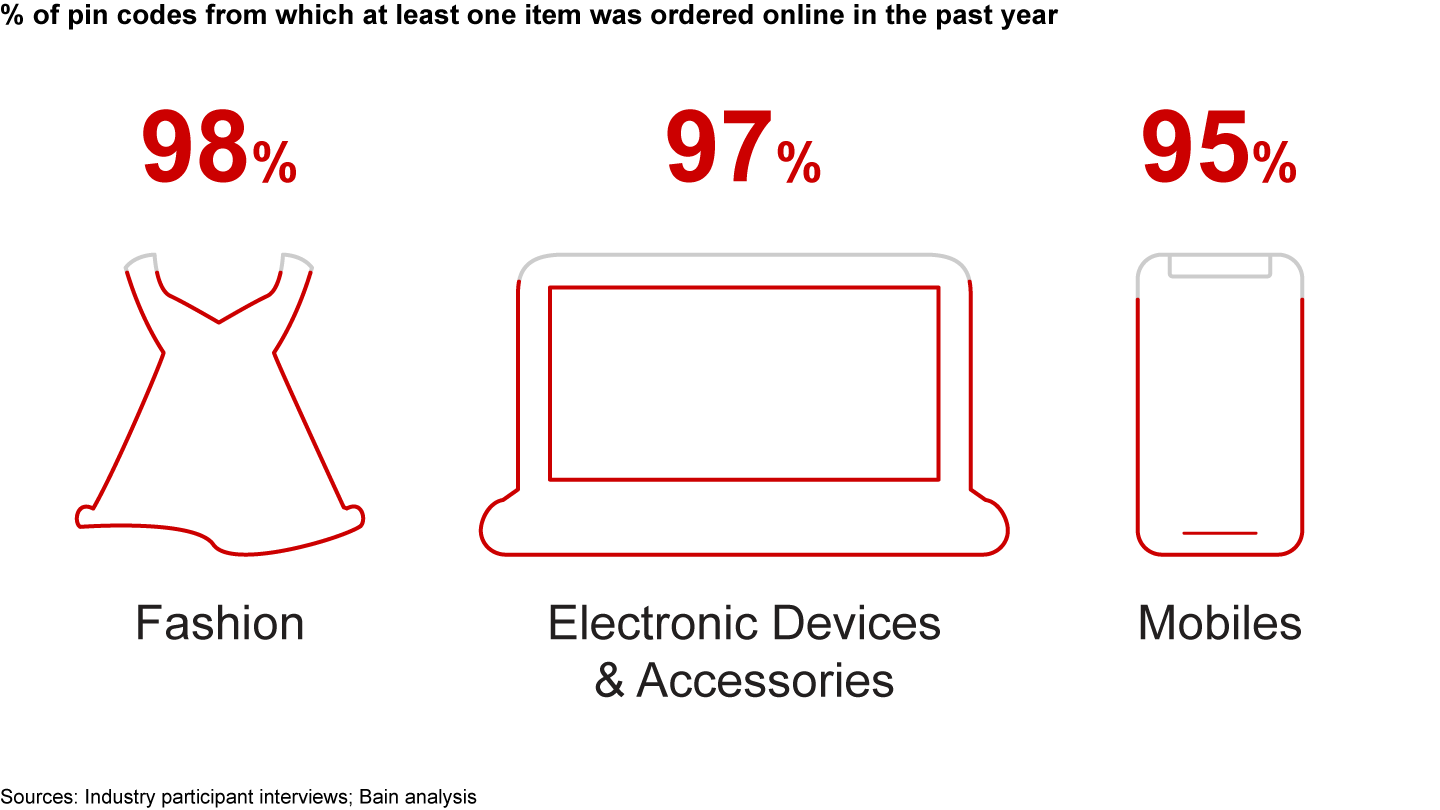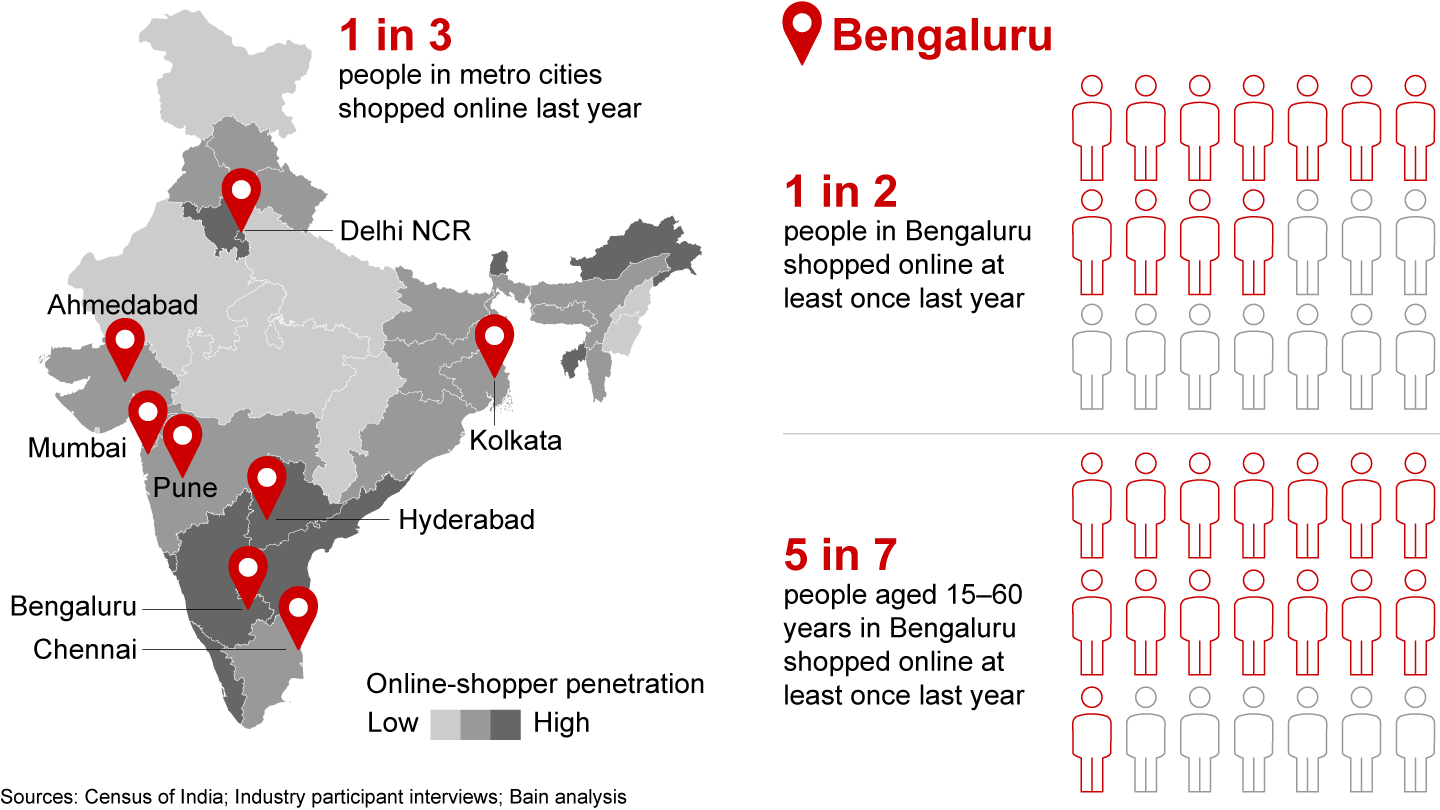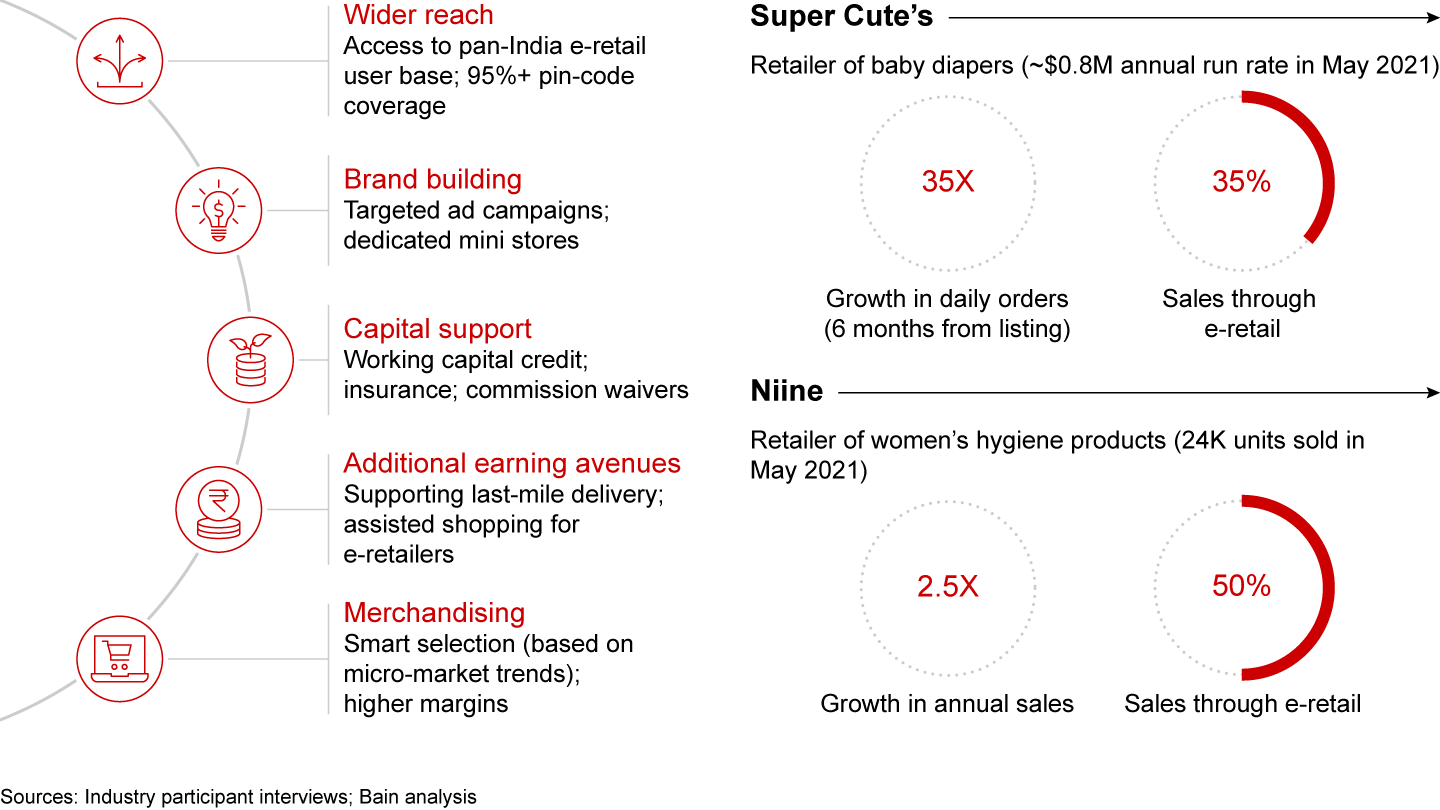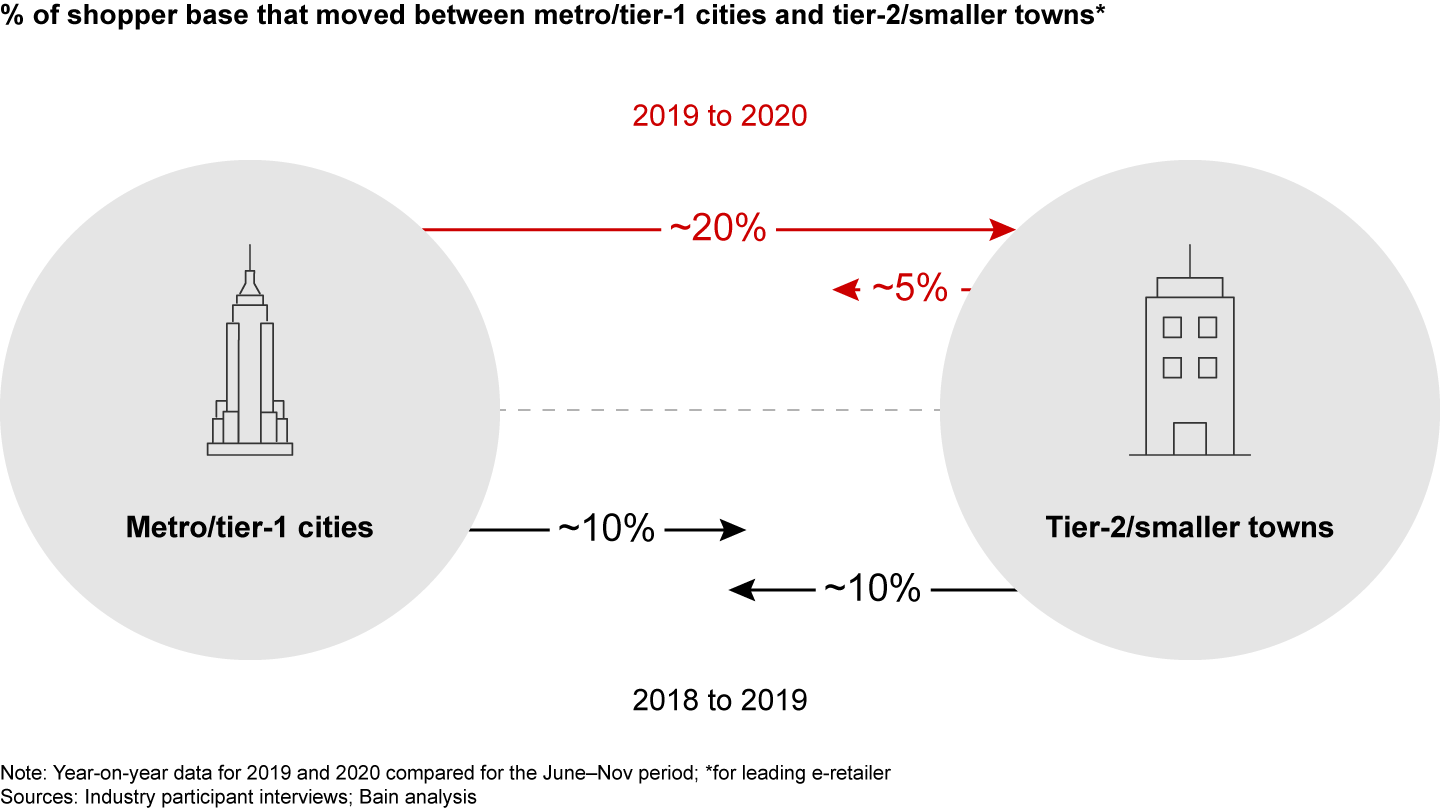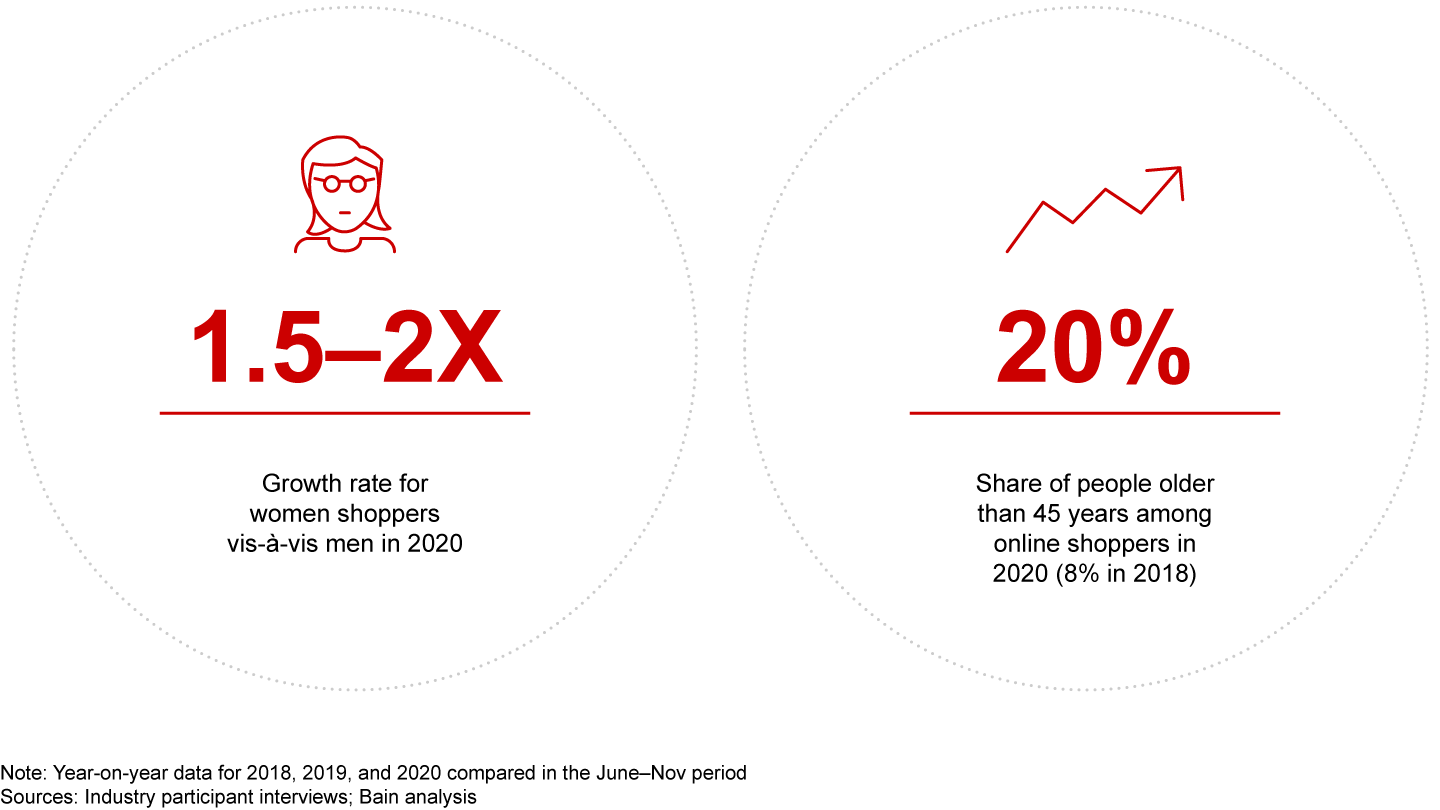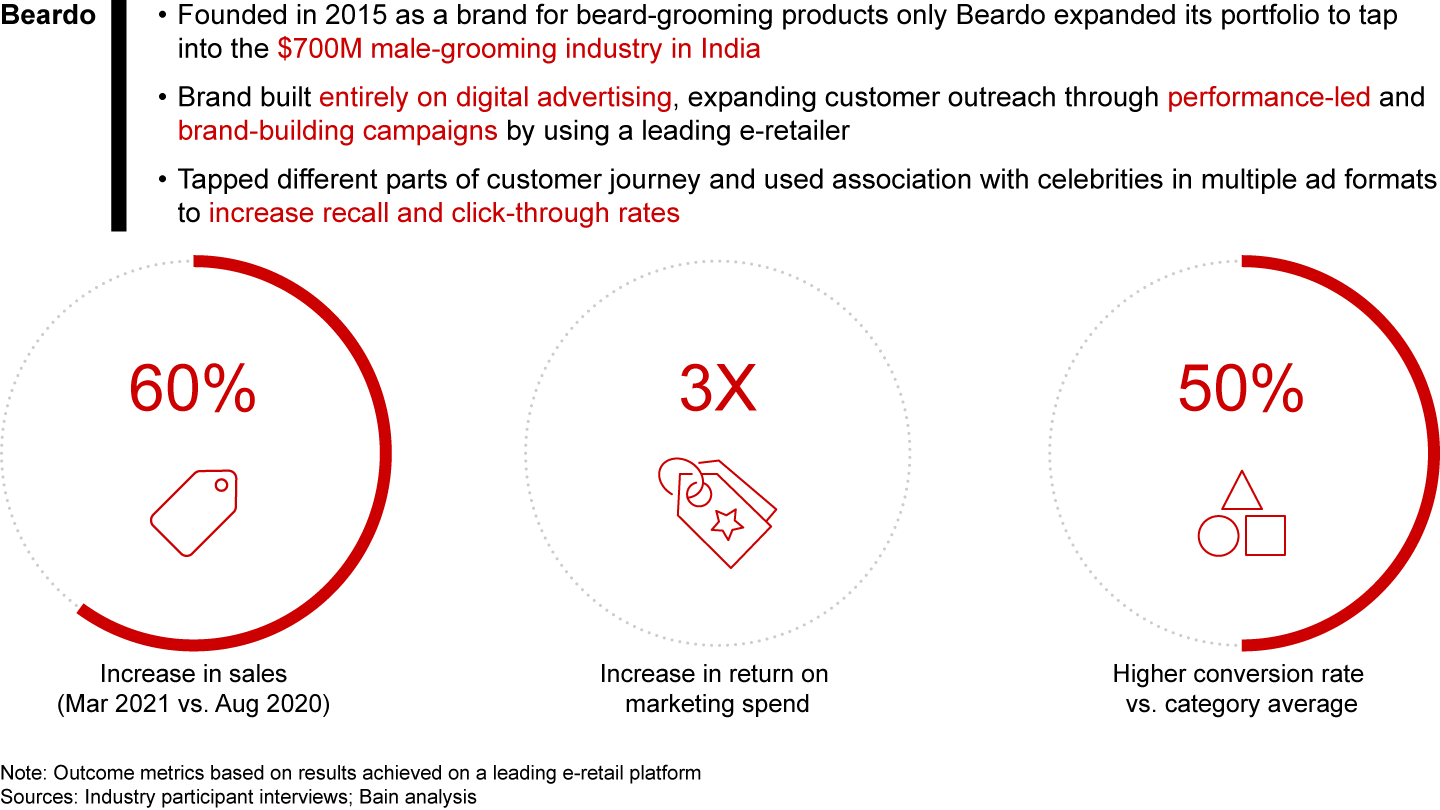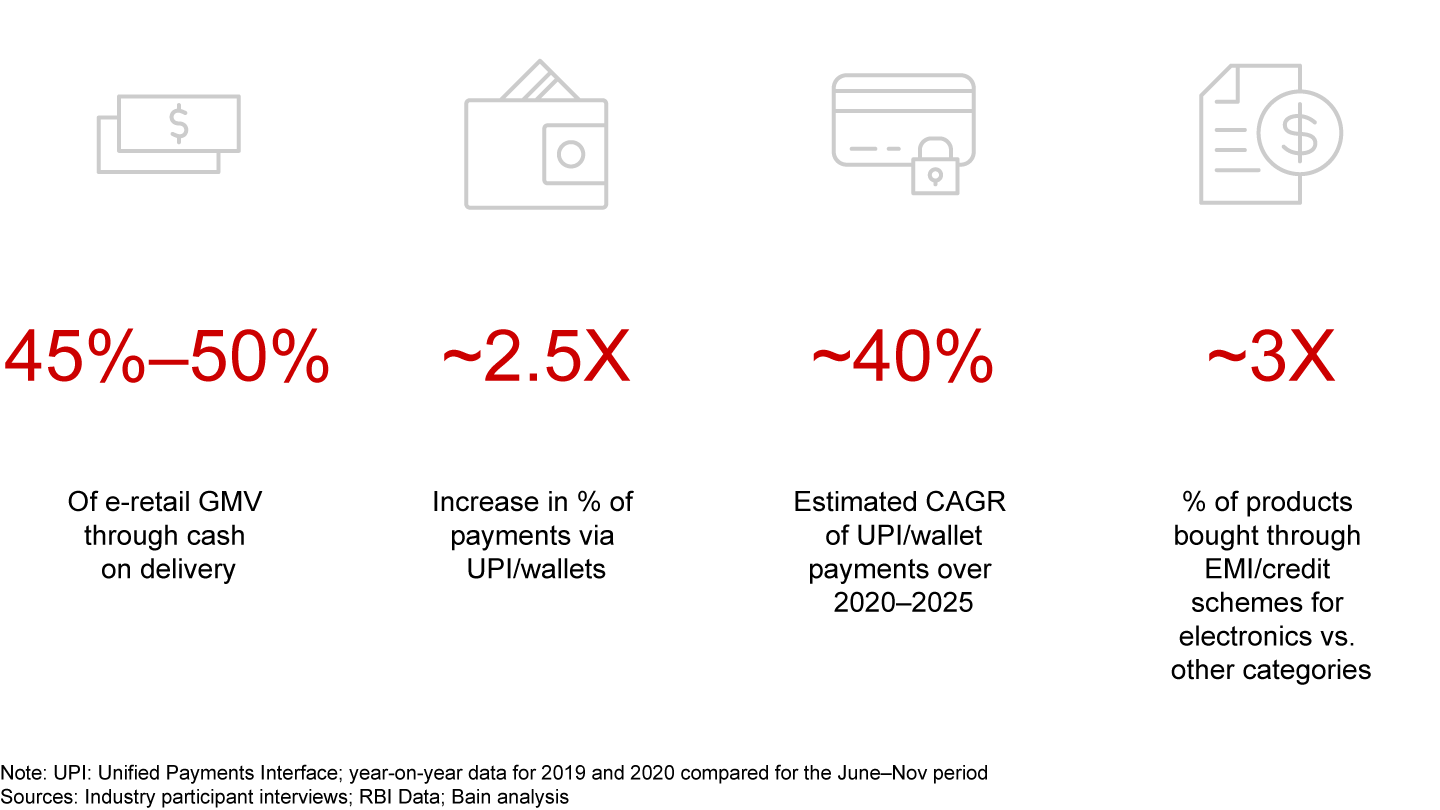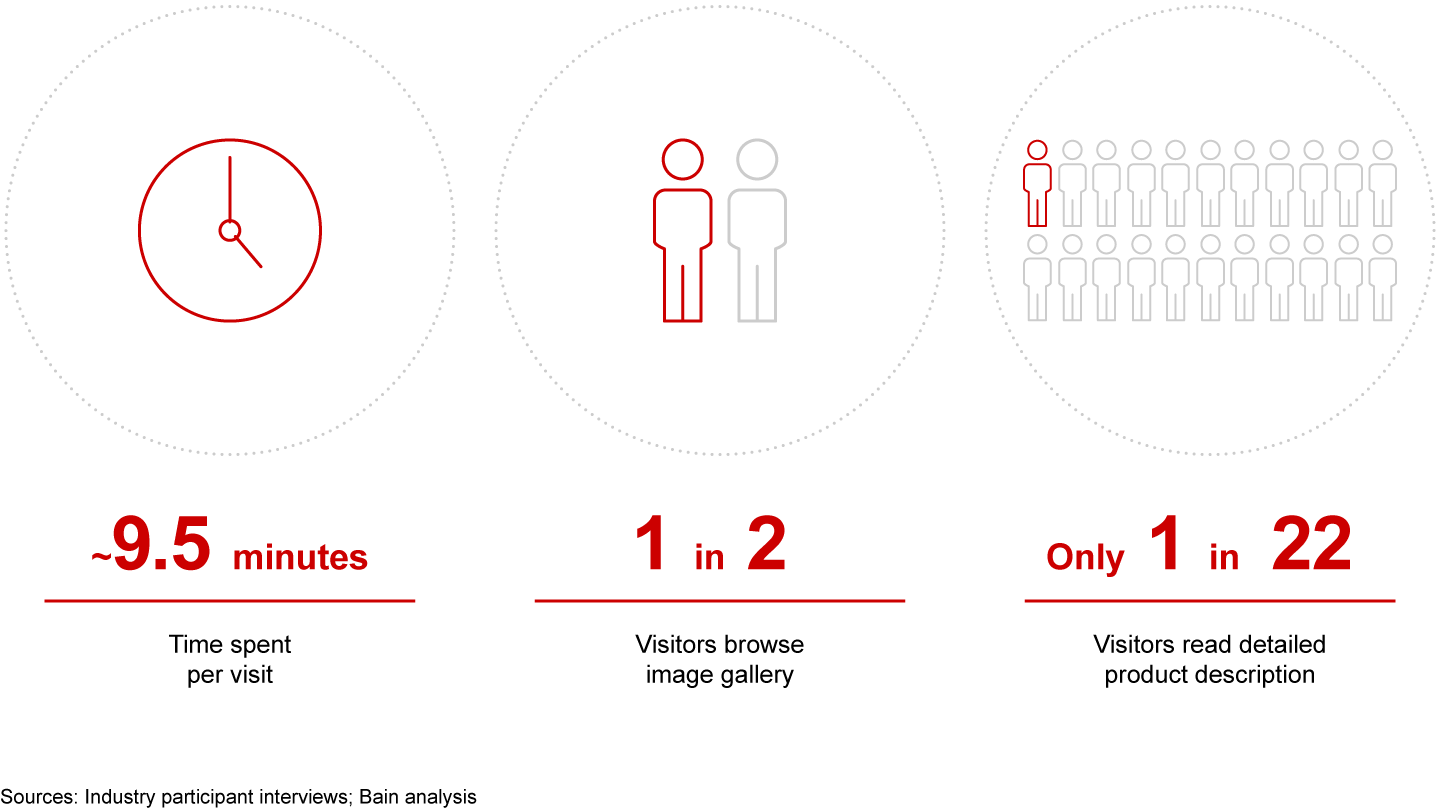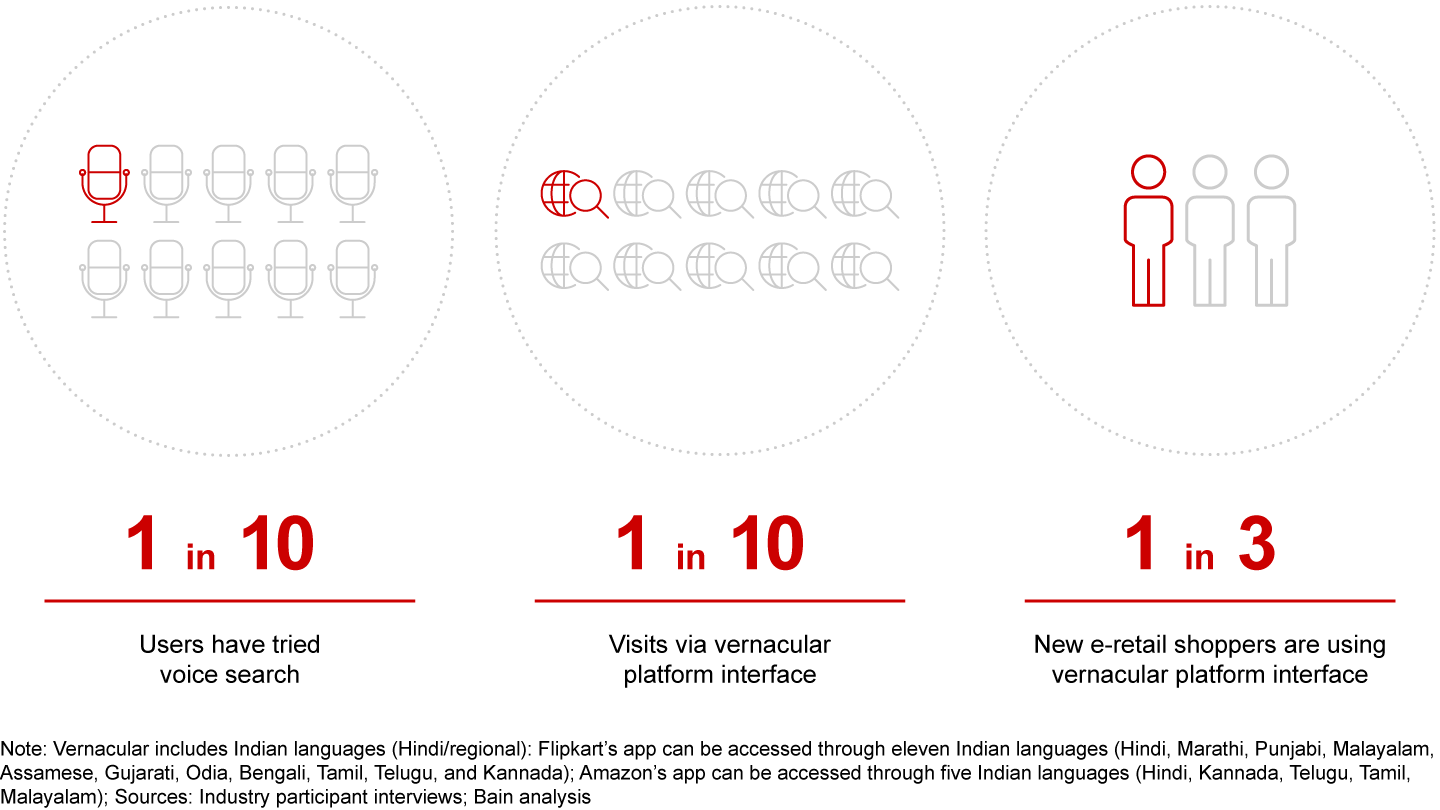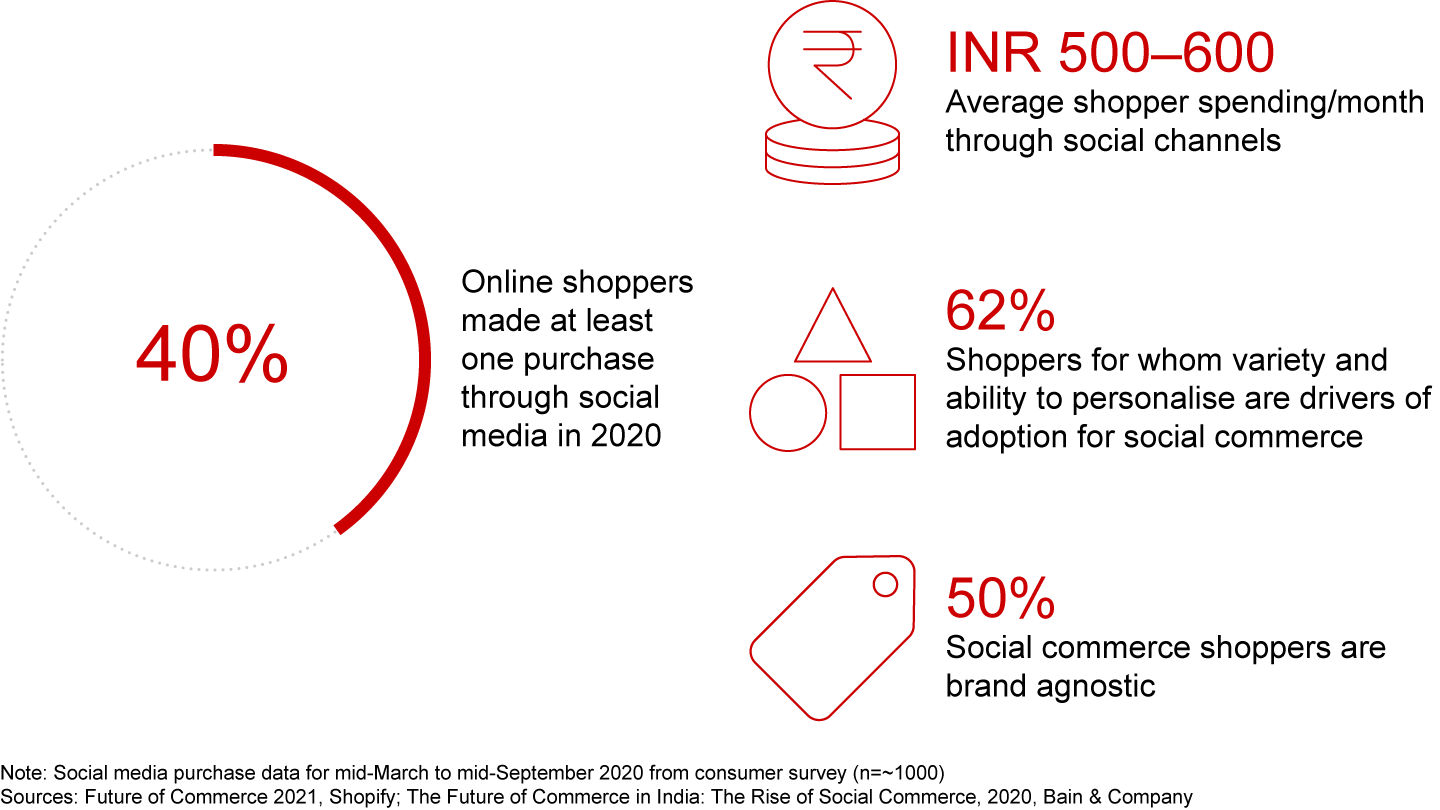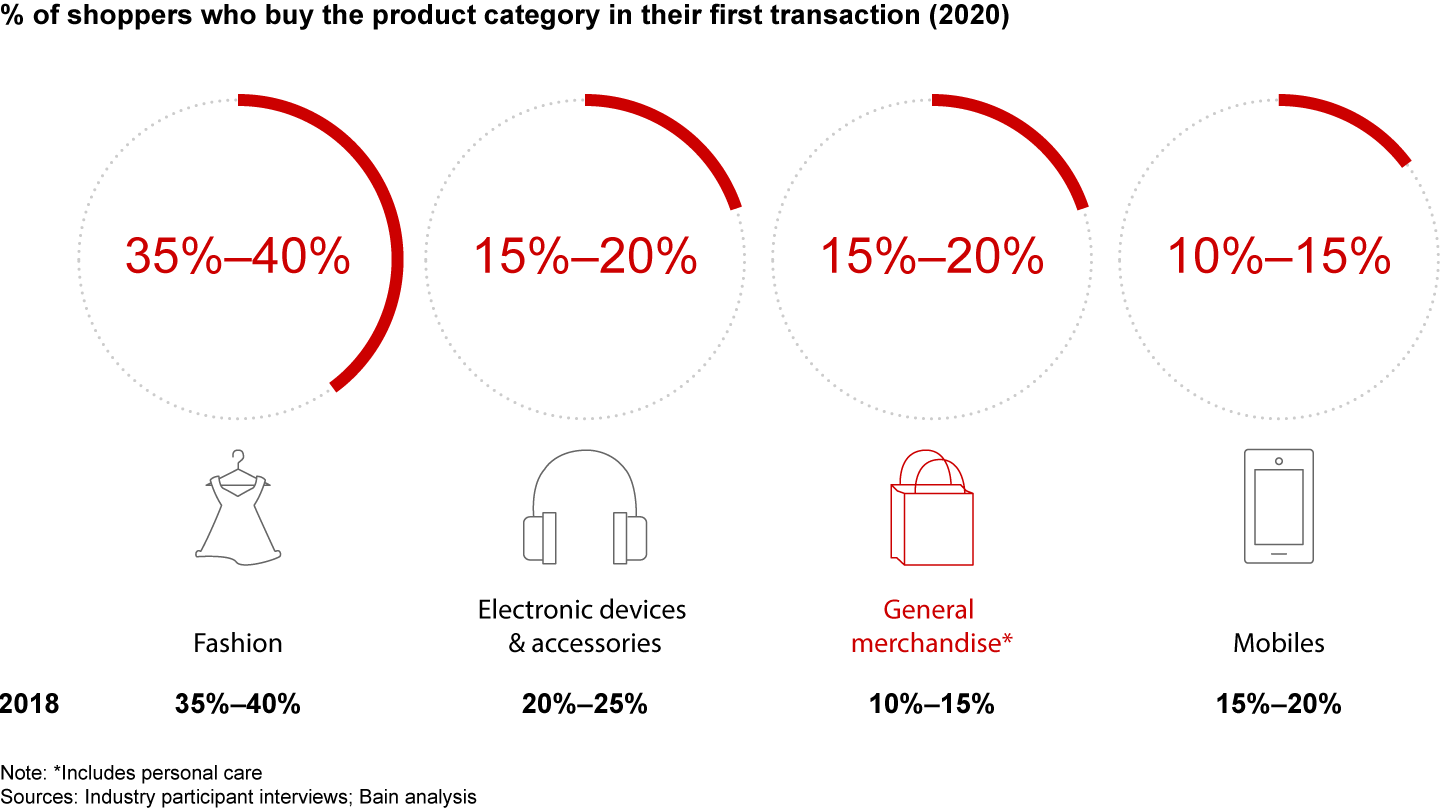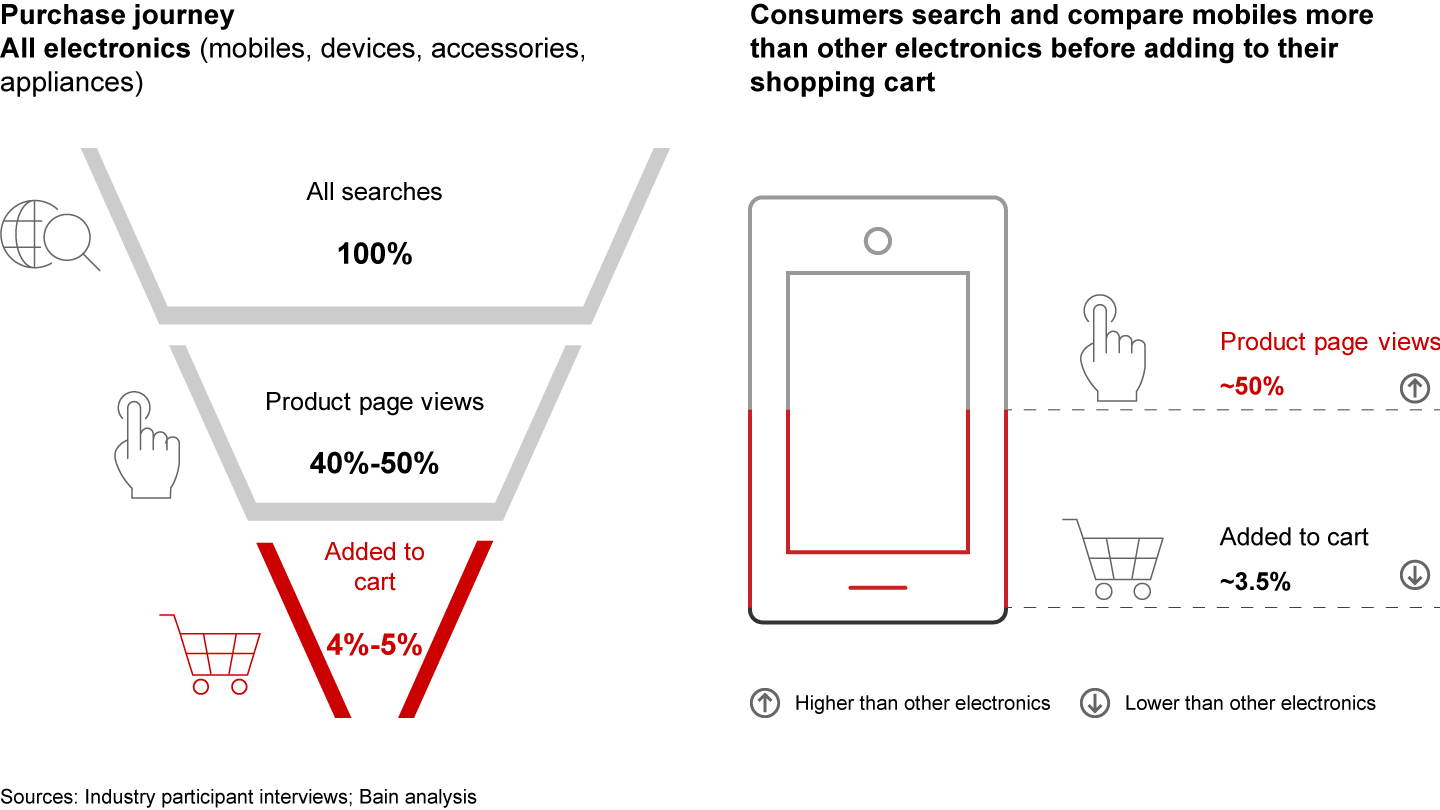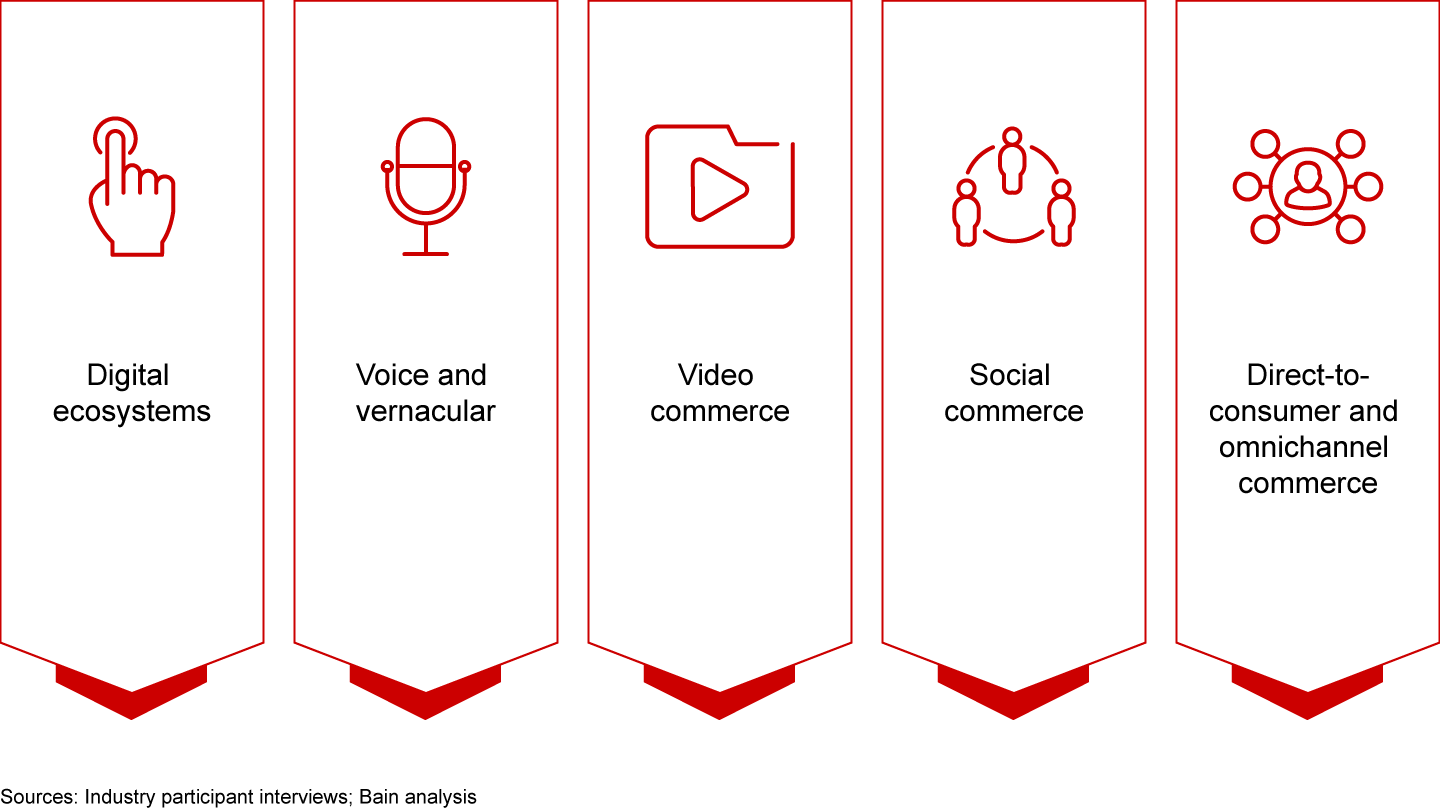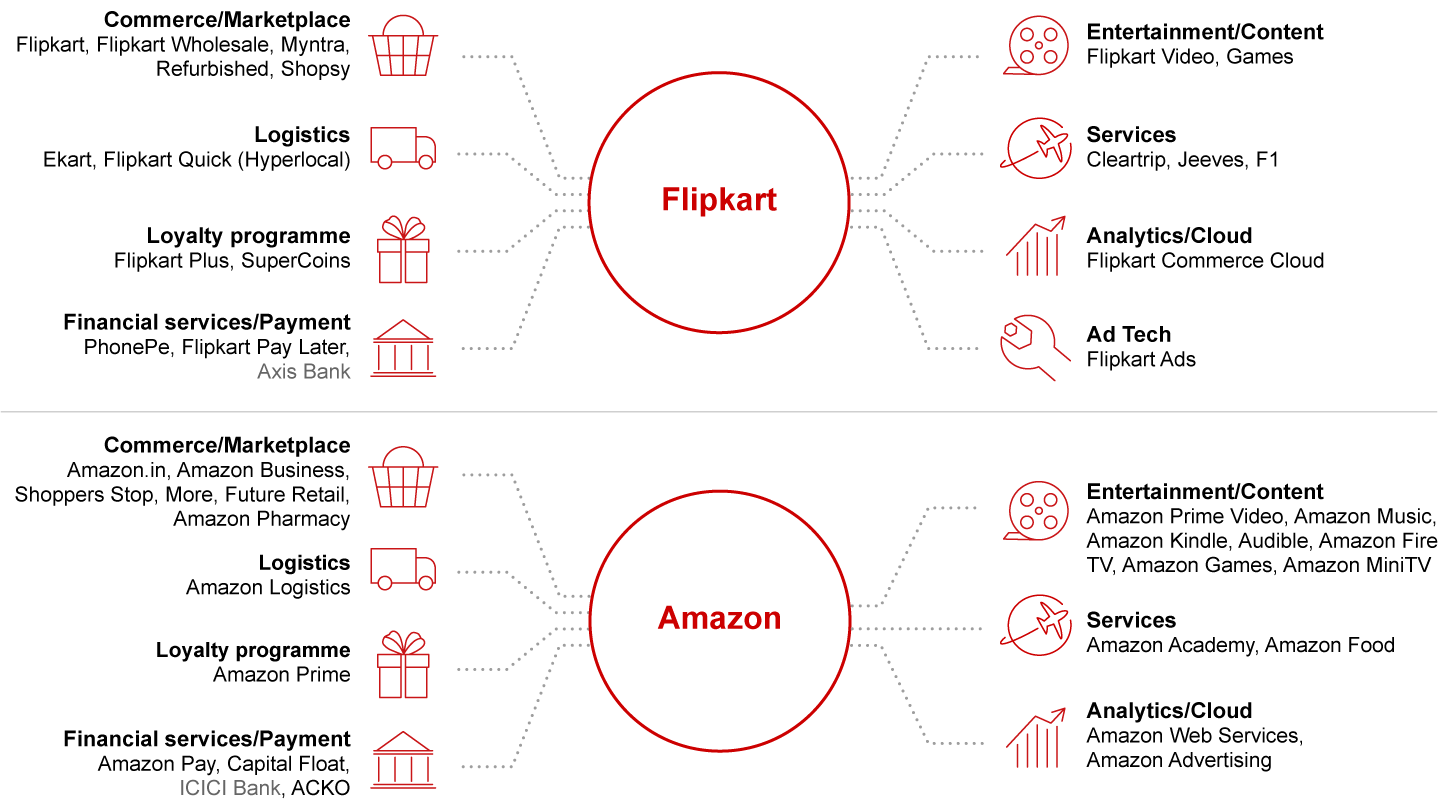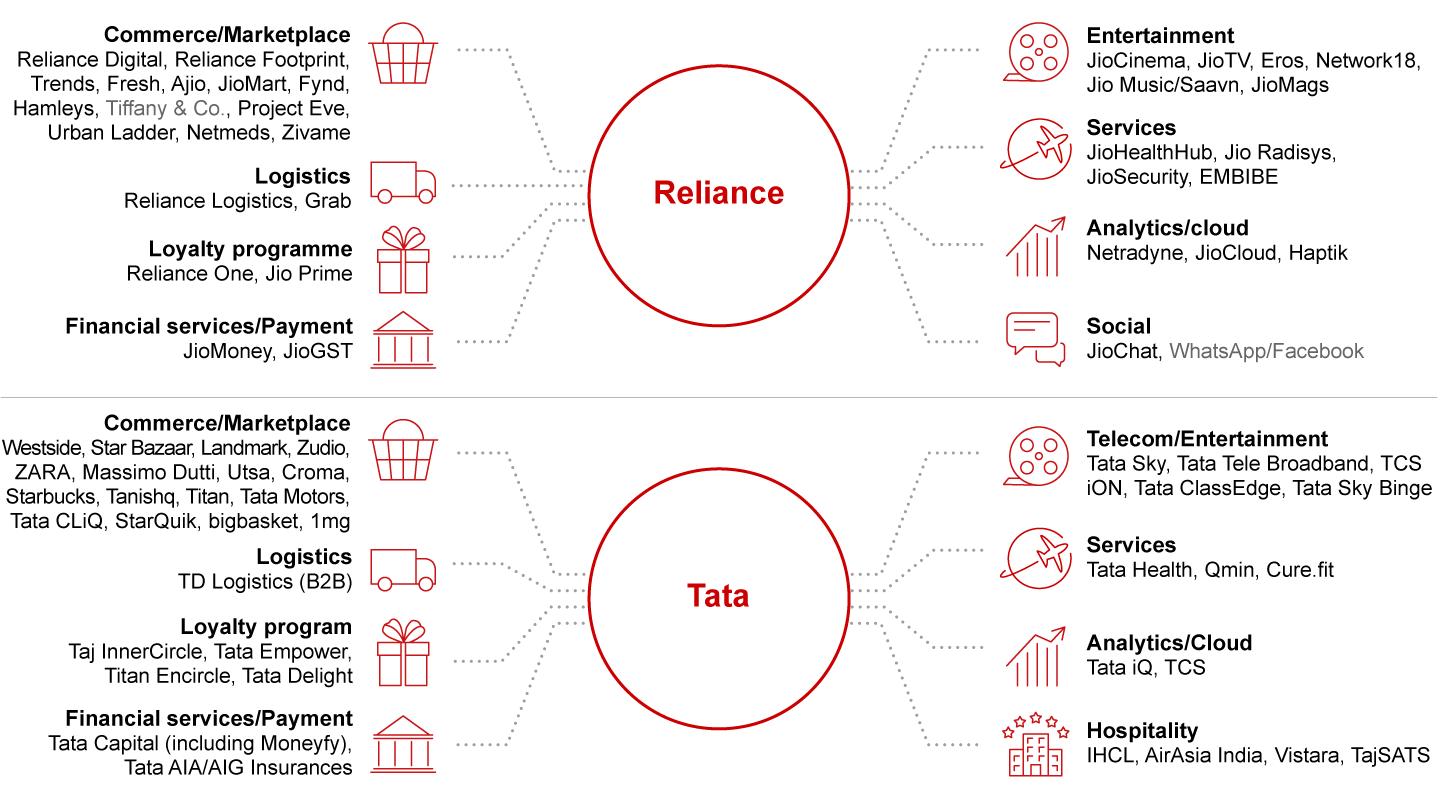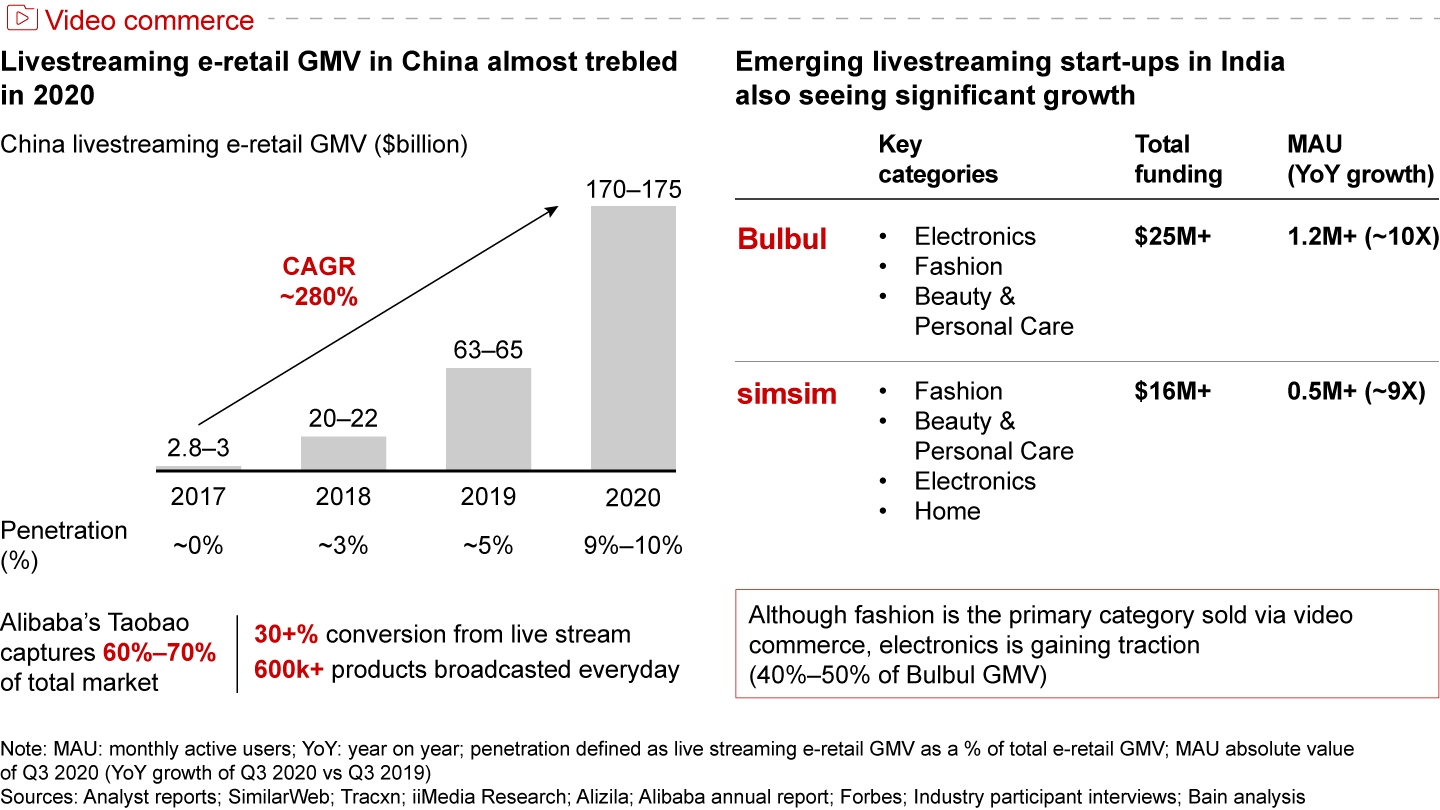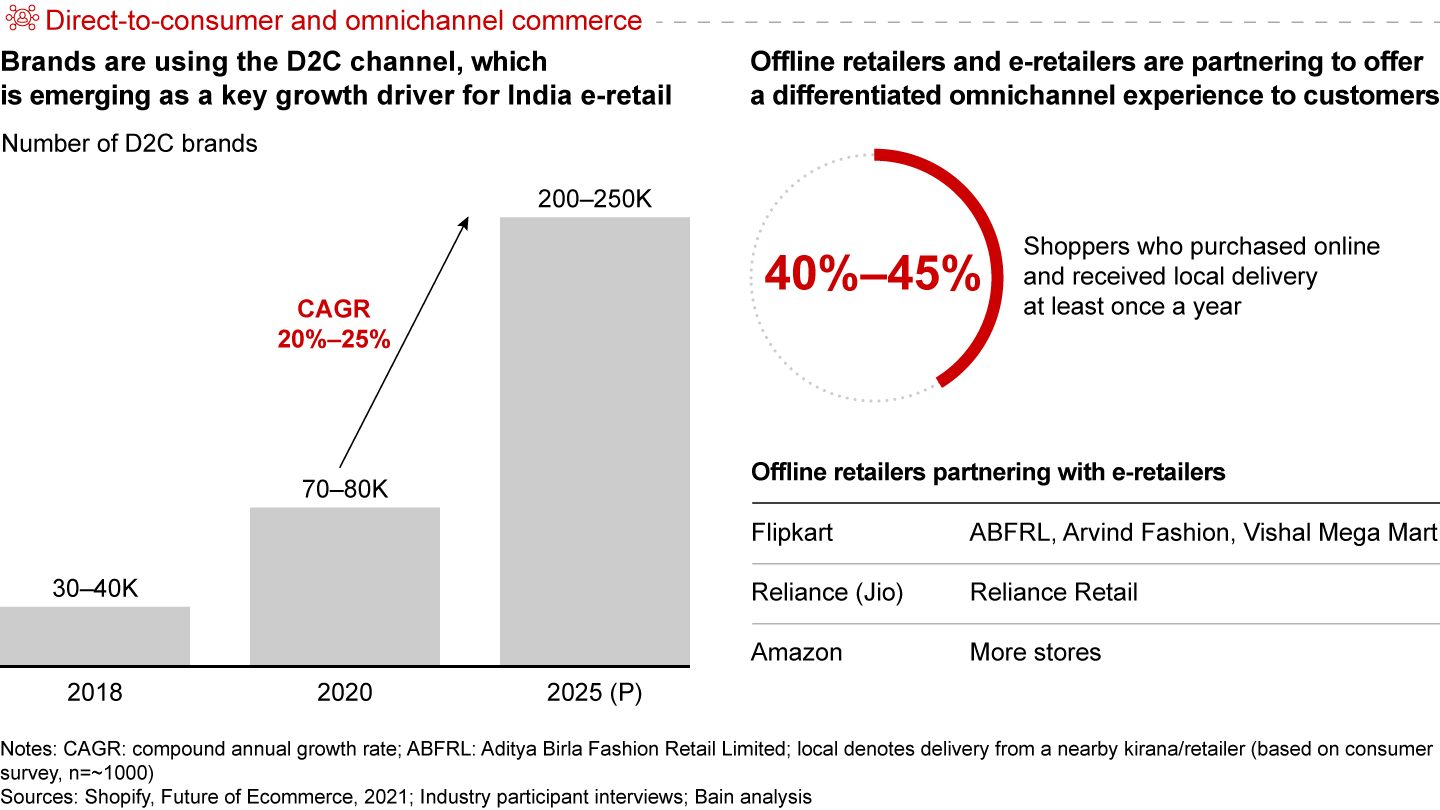Report

Executive Summary
India’s online shopping landscape after the pandemic
India is one of the largest consumer economies globally. The $810 billion Indian retail market is the fourth largest in the world and is quickly evolving to include a sizeable e-retail component. India is home to the third-largest online shopper base of 140 million, only behind China and the US. However, the market is still massively untapped, and there is immediate potential to reach India’s large Internet user base of approximately 625 to 675 million people.
Written in collaboration with
Written in collaboration with

The fiscal year ending March 2021 was one of contrasts for India’s retail market. The overall retail market shrunk by 5%, along with a 7.3% contraction in GDP. However, the Indian e-retail market saw a 25% growth despite a two-month national lockdown and multiple prolonged disruptions in regional pockets over the year.
The pandemic was a watershed moment for India’s e-retail market, driving a 12-month acceleration in e-retail penetration, which was at 4.6% by the end of FY21. This acceleration was even higher in the top eight metro cities, where online shopping is more common: one in three people shopped online at least once last year in the top eight metro cities.
This Covid-19–induced inflection in e-retail is a global phenomenon driven by an enhanced consumer need for safety and convenience especially during elongated stay-at-home periods. This has also played out in India wherein e-retailers have been the lifeline for both consumers and sellers—enabling access to essential commodities and hygiene products to millions of households during the lockdown, and providing business avenues to thousands of sellers. We expect the surge in penetration to sustain post stabilisation, as a similar trend has been seen globally.
E-retail categories have seen disparate growth and recovery patterns during the pandemic. First, select categories (e.g., mobiles, electronics, appliances) saw a massive one-time spurt that then cooled off due to longer replacement cycles and recovery of offline retail. These categories did not see as substantial a jump during the second wave over April–May 2021. Second, frequent-use categories (e.g., groceries, household, personal care) saw rapid growth and are likely to continue seeing accelerated growth post-pandemic. These habit-forming categories, which have a high share of repeat purchases online, also benefited from a concerted push to accelerate digital sales by leading brands that were not as invested in this channel pre–Covid-19. Third, discretionary and out-of-home spending categories (e.g., fashion, travel products) saw relatively slower growth during the pandemic. We expect growth rates in e-retail spending for these categories to rebound to pre-pandemic levels soon and then follow long-term growth trajectories.
E-retail continues to benefit millions of shoppers across India, driving ubiquitous access and heightened convenience. It has democratised shopping by providing access to more than 95% of India’s pin codes. It has empowered Bharat’s small sellers and micro-entrepreneurs, broken go-to market barriers for incumbent and insurgent brands, and provided employment to millions. E-retail has particularly been a boon during the pandemic after the setbacks caused by widespread disruption (for consumers and small businesses) and loss of jobs.
In the future, the e-retail market is expected to grow to $120–140 billion by FY26, increasing at approximately 25%–30% per annum over the next five years. The growth will be led by smaller towns, which account for four out of five new shoppers. In addition to small towns, women and older shoppers have gained prominence in the online shopper base over the last year, and this trend is expected to continue.
Online shopping journey
A deep understanding of the consumer shopping journey—from discovery to purchase—forms the bedrock of e-retail success for leading digital brands. In addition to cross-category shopping habits, we have zeroed in on the electronics category to better understand consumer shopping behaviour. Brands must study this behaviour as they look to scale their digital presence and grab a larger share of online shopping in their categories. Key insights for brands and platforms include:
Cut through the clutter and do it fast: An e-retail visitor spends fewer than 10 minutes per visit on a platform. Shoppers browse 10 product pages, on average, in electronics, and more than 15 in mobiles before adding any to their cart. Brands and sellers have limited time to tell their story and make an impression in the minds of the consumers. Images are key—1 in 2 visitors browse image galleries, whereas only 1 in 22 read product descriptions.
Voice and vernacular are no longer niche: 1 in 10 platform users adopt voice search, and 1 in 3 new e-retail users visit through a vernacular platform interface. Voice and vernacular searches will increasingly become mainstream.
Category-led nuances in search patterns: Search patterns and habits vary by product. Shoppers primarily search by brand names when buying mobiles and televisions; however, they search by product categories for items like laptops and large appliances (air conditioners, refrigerators, washing machines).
Influencers have a growing influence: Approximately 40% of online shoppers made at least one purchase through social media channels (e.g., Facebook, Instagram, WhatsApp) in 2020. Content creators and influencers will play an increasingly critical role in the future of commerce.
Digital payments are gaining fast, but cash remains key: Use of digital payments and credit has accelerated significantly, although cash purchases continue to account for approximately 45% to 50% of the e-retail gross merchandise value (GMV), even during the pandemic. The use of credit is more pronounced in the electronics category, with three times more adoption of equated monthly instalment (EMI) or credit schemes vs. other categories.
Future of online shopping
As e-retail accessibility continues to expand, a new wave of shoppers will come online. The majority of these future online shoppers are likely already in the digital funnel—watching videos and using chat and social media apps, but e-retailers will need to accelerate their transition to commerce. This involves a deep understanding of their needs and interaction patterns with brands and platforms. As firms look to out-innovate each other to win this next generation of online shoppers, we envision six mega-trends playing out in the India e-retail ecosystem:
Digital ecosystems: The pandemic provided a strong stimulus to all digital services (e.g., payments, health tech, ed tech). Large e-retailers have started creating scale ecosystems, serving as a one-stop shop for digital and retail needs. These ecosystems use sticky offerings such as video streaming and gaming to drive consumer engagement and capture a larger share of consumer time and spending.
Voice and vernacular: Voice and vernacular are core to attracting the next generation of consumers. Use of voice-assistant apps doubled to approximately 5–6 million monthly users in 2021 (average until May). Web pages were translated to vernacular languages approximately 50% more in 2020 compared with 2019. Use of vernacular-language apps such as ShareChat and Daily Hunt continued to accelerate through the pandemic.
Video commerce: The video-watching user base expanded greatly during the pandemic and grew by 25% in India in the past year alone, increasing to 350–400 million users. Hundreds of thousands of creators will help propel livestreaming and video-enabled commerce significantly in the coming years. Multiple livestreaming commerce start-ups have already emerged in India and are growing rapidly. In China, livestreaming commerce accounts for 9%–10% of overall GMV.
Social commerce: Peer and community influence will play a much more significant role for the next wave of online shoppers. Social commerce GMV (approximately $1.5–2 billion in FY20) could grow at a 55%–60% compound annual growth rate (CAGR) over FY20–25, with the potential to empower 40 million small businesses and turbocharge women entrepreneurs. This will further democratise e-retail, with three in five social shoppers coming from tier-2/smaller towns.
Direct-to-consumer (D2C): Brands are looking for more ways to directly engage with consumers and give them a differentiated experience. There has been an explosion in D2C brands in India—both established and insurgent (nearly doubled from two years ago)—accelerated by the pandemic.
Omnichannel commerce: Consumers are increasingly switching between offline and online touchpoints across their purchase journey. Offline retailers are also increasingly going online and are partnering with e-retailers to offer consumers a seamless experience.
India’s online shopping landscape after the pandemic
- India has the third-largest online shopper base globally, with 140 million e-retail shoppers in 2020, only behind China and the US.
- The fiscal year ending March 2021 showed contrasts in India’s retail market: the overall retail market shrunk by 5%, along with a 7.3% contraction in GDP due to sustained lockdowns across India. However, the e-retail market surged by 5% to reach $38 billion despite a multimonth lockdown. This was driven by Covid-19, which caused increased adoption of online channels.
- Covid-19 provided a massive stimulus to India’s e-retail penetration, accelerating it by 12 months to reach approximately 4.6% in FY21. This increase was even greater in metro cities, as one in three people shopped online at least once across the top eight metro cities last year. Bengaluru led the way, with one in two people shopping online at least once last year. Global e-retail markets indicate that increases should remain, sustaining at levels higher than before the Covid-19 pandemic, albeit lower than peak levels.
- E-retail categories have seen disparate growth and recovery patterns through the past 12–18 months of the pandemic: The mobiles and electronics categories witnessed a one-time growth spurt; frequent-use categories such as grocery, household, and personal care saw continued acceleration; and discretionary categories such as fashion and travel products saw relatively slower growth but have started rebounding in 2021.
- The India e-retail market is expected to grow at 25%–30% annually over the next five years to reach $120–140 billion by FY26, which is higher than Modern Trade. Small-town India will fuel this growth, accounting for four of every five new shoppers. During the pandemic, reverse migration from metro cities further accelerated growth in smaller towns. In addition to small towns, women and older shoppers continue to increase the e-retail base.
- E-retailers played a mission-critical role in maintaining essential food and hygiene products for millions of Indian households during the lockdowns. E-retailers were the lifeline of both consumers and sellers. Delivery across more than 95% of India’s pin codes allowed consumers to shelter at home and prevent the spread of disease. Simultaneously, e-retailers helped Bharat’s small sellers and brands (especially insurgents) overcome go-to-market barriers and reach consumers despite widespread disruption.
Online shopping journey
- Brands and sellers have fewer than 10 minutes to win the online shopper. The shopper journey varies widely by subcategory. For example, even within electronics, shoppers browse 10 product pages, on average, before adding a product to their cart. Brand-specific search is most common for mobiles, audio, and television, but product-specific search is used most for laptops and large appliances. To increase conversion, sellers must invest in high-quality product images—1 in 2 visitors browse images, whereas only 1 in 22 read detailed product descriptions.
- The role of voice, vernacular, and social media in online shopping is expanding. Voice and vernacular are vital to attract the next generation of online shoppers—1 in 10 users have tried voice search, and 1 in 3 new users use a vernacular platform interface. Influencers and social media channels are also increasingly nudging consumers to shop online—in 2020, 40% of online shoppers made at least one purchase through social media channels (e.g., Facebook, Instagram, WhatsApp, etc.).
- Fashion, electronics, general merchandise, and mobiles continue to be key gateway categories for new online shoppers. Whereas fashion continues to lead as a first purchase (35%–40% new shoppers bought fashion in their first transaction in 2020), general merchandise increasingly attracts first-time online shoppers (15%–20% of shoppers bought general merchandise in their first transaction in 2020 vs. 10%–15% in 2018).
- E-retail customers are increasingly opting for digital payments and credit to complete online purchases. However, cash continues to account for 45%–50% of e-retail GMV. Use of credit is especially pronounced in electronics, with three-times higher share of products bought on credit vs. other categories.
Future of online shopping in India
The online-shopper landscape is continuously evolving. We envision a few notable megatrends that will shape the future of online shopping in India as e-retailers and D2C brands look to attract the next millions of shoppers:
- Digital ecosystems: Digital leaders are building scale ecosystems to capitalise on the rapidly growing user base across the digital funnel. Flipkart, Amazon, Reliance Jio, and Tata offer multiple digital services to capture an outsized share of consumer time and spending.
- Voice and vernacular: The next wave of India’s Internet users prefer voice-search and vernacular-based user interfaces. The user base for voice-assistant apps approximately doubled to 5–6 million monthly users in 2021 (average until May). Webpage translation to vernacular languages increased 1.5x in 2020 (vs. 2019). Digital platforms will continue to invest in voice and vernacular capabilities to attract the next generation of online shoppers.
- Video commerce: Video content consumption has gained traction and has given birth to a substantial community of local creators and influencers. These creators are looking to monetise their following and are likely to drive an uptick in video commerce. Livestreaming commerce start-ups such as Bulbul and Simsim have seen 9–10x growth in user base over the last year. In China, livestreaming commerce already accounts for 9%–10% of GMV.
- Social commerce: Millions of smaller retailers are finding innovative ways to sell directly to consumers through many social formats. Social-led models are empowering Bharat’s sellers and women entrepreneurs, and three of every five shoppers now come from tier 2/smaller towns. Social commerce is expected to increase from $1.5–2 billion in FY20 to $16–20 billion in FY25, growing at 55%–60% CAGR.
- Direct-to-consumer and omnichannel: Growing popularity of online shopping has pushed established and digitally native brands to opt for a D2C channel via their websites. D2C brands have nearly doubled over the last two years, with the pandemic further accelerating this trend. Offline retailers and e-retailers are increasingly partnering to offer a differentiated omnichannel experience to consumers.
Growing relevance of the online channel has made it a must-play and must-win frontier for brands. Winning an outsized share of online consumer spending requires a series of investments. This includes investments in visibility, supply chain, merchandising, conversion, and key capabilities (e.g., organisation).
